Evaluation of Teaching Quality of English Courses in Comprehensive Universities under Multiple Indicators
Abstract
With the continuous development of internationalization and the task of cultivating graduates with high comprehensive quality for the society, the importance of English teaching in comprehensive universities has been increasing. In this paper, based on the analysis of the evaluation subjects of university English teaching quality, 16 evaluation indexes are constructed from five aspects: teaching content, teaching method, teaching process, teaching literacy, and teaching effect, and the Particle Swarm Optimization-Least Squares Support Vector Machine (PSO-LSSVM) algorithm is used to comprehensively evaluate the teaching quality, and finally English teaching in universities is selected as the object of empirical research. The research results show that PSO-LSSVM algorithm has high applicability in evaluating ECCU and can provide over reference for universities to improve teaching quality and develop reform programs. Due to the lack of training data, although the evaluation index system in this paper is scientific and feasible, it still needs to be further adjusted and optimized according to the specific practice situation.
1. Introduction
With the acceleration of internationalization, English proficiency is an important assessment indicator for advanced talent for students from non-native English speaking countries. Therefore, university education includes not only solid majors, but also needs to develop language communication skills in order to contribute to the optimization of the talent structure of society [1, 2]. With the rapid development of higher education informatization, teaching quality evaluation has gradually become a key part of current teaching activities. Teaching quality evaluation work for comprehensive universities occupies an important main position as the core work in the process of educational evaluation [3]. Educational evaluation refers to the use of science and technology and other methods to realize the value judgment of educational effects according to the established standards and purposes, and its key lies in the formulation of evaluation contents and the establishment of standards. It is capable of evaluating educational work by conducting qualitative and quantitative analysis on the basis of following the actual needs of society and the laws of talent training and development. Educational evaluation is one of the important signs of scientific and democratic modern educational management. The core basis of teaching evaluation is teaching quality evaluation, which is the process of realizing the value fragment of teaching quality effectiveness and plays an indelible role in improving the teaching methods of schools, improving the quality of school operation, and promoting the development of education work. Currently, the state is paying increasing attention to the evaluation of teaching quality in comprehensive universities and has carried out multiple forms of evaluation, such as the evaluation of teaching laboratories for undergraduate professional basic courses and technical basic courses. The macro control of university teaching quality by means of evaluation has in turn promoted the research related to teaching quality evaluation. As an important public basic course, college English is an important course for comprehensive colleges and universities to cultivate talents [4]. Therefore, the evaluation of the teaching quality of college English is an effective way to promote the teaching reform of English courses.
Research scholars in the evaluation of university English teaching quality mainly focus on two aspects of evaluation index system and evaluation methods. The teaching quality evaluation index system of colleges and universities should be systematic, comprehensive, and focused [5, 6]. In terms of the evaluation index system, Yafeng divided the evaluation indexes into five aspects of teaching content, teaching methods, teaching attitude, professionalism, and teaching effectiveness, and 10 evaluation indexes in evaluating the quality of physical education classroom teaching in universities [7]. Hysa developed the evaluation index system in accordance with the relevant national documents. The key determinants affecting students’ learning methods will directly affect the quality of teaching and learning, including three main aspects: resources, effectiveness, and student participation [8].
In terms of evaluation methods, Ansari et al. used the goodness of fit index (GFI) and comparative fit index (CFI) to assess teaching quality. Cronbach’s assessment of alpha was used based on internal consistency reliability [9]. On the basis of simplifying indicators by factor analysis and cluster analysis, Lei combined with moving edge to calculate indicator weights and used the fuzzy comprehensive evaluation model for teaching quality evaluation [10]. Zhang used the Online Analytical Processing Support Vector Machine (OLAP-SVM) classification algorithm to construct a linear optimal decision function in the feature space to evaluate the quality of college education [11]. The Support Vector Machine (SVM) algorithm can obtain high-quality classification results with high accuracy by training on sample data [12]. Combined with Particle Swarm Optimization (PSO) algorithm it is more capable of collaboration and information sharing among individuals to find the optimal solution, therefore, Particle Swarm Optimization-Least Squares Support Vector Machine (PSO-LSSVM) is chosen as the algorithm for English Courses in Comprehensive Universities (ECCU) evaluation model in this paper [13].
In this paper, teaching content, teaching methods, teaching process, teaching literacy, and teaching effectiveness in English classrooms of comprehensive universities are taken as the first-level evaluation indexes, and 16 second-level evaluation indexes are set with full consideration of the practice of ECCU and the evaluation objects. Based on the consideration of various factors, the ECCU evaluation index system is constructed, and the evaluation results are divided into four levels, and the PSO-LSSVM algorithm is used to conduct an empirical study, based on the evaluation results to provide reference for the reform and quality improvement of English teaching in comprehensive universities.
2. Evaluation Index System
The construction of university English teaching evaluation system should pay attention to the penetration of teaching management concept, which aims to improve the teaching quality of comprehensive universities and requires teachers to use modern teaching management concept and fully understand the actual situation of current university English teaching and social development needs. The university English teaching evaluation index system constructed in this paper aims to take teachers as the evaluation subject and teaching quality as the evaluation content. Therefore, when selecting evaluation indexes, it is necessary to consider all aspects of teaching activities and establish the evaluation index system on the basis of understanding the people involved in teaching activities.
The teaching activities involve many links from organization to implementation, and the entity objects related to them mainly include teaching affairs department, teaching guarantee department, expert supervisor, faculty, teaching and research department, teachers and students. The academic affairs department is responsible for the organization and supervision of teaching activities, and grasps the whole information of the implementation of teaching activities. The teaching guarantee department, on the other hand, is responsible for the guarantee of teaching activities such as teaching materials and teaching venues. Expert supervisors, on the other hand, are teaching experts hired by the academic affairs department to evaluate teachers through their teaching experience and have a greater say in the evaluation of teachers’ working ability and teaching quality. The faculty is in a leading position in teaching activities and is responsible for teaching management and supervision. The faculty directly manages the teaching professors, and the faculty members in the same faculty have a better understanding of each other’s teaching ability, work attitude, and teaching quality. Teachers can analyze their own teaching level through self-evaluation. Students are the recipients of teaching activities, and they have the most contact and closest relationship with teachers, which can best reflect teaching ability and teaching quality. Based on the above analysis, this paper mainly constructs an evaluation index system from the evaluation of college English classroom teaching, and divides the evaluation of college English teaching quality into five aspects: teaching content, teaching method, teaching procedure, teaching literacy, and teaching effect. The evaluation index system of ECCU constructed in this paper is shown in Figure 1.
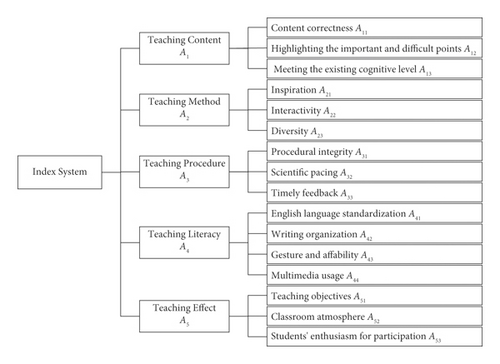
Teaching content refers to whether the content of instruction for the subject of English is correct and scientific, on the basis of which it also needs to be focused and difficult. What is more, it needs to fit in with the teaching objectives and pay attention to the three-dimensional goals of students’ success and the improvement of scientific literacy. In addition, the learning content should not be detached from the actual needs of students’ life and social development and their existing cognitive level [14]. Therefore, the indicators in terms of teaching content include content correctness A11, highlighting the important and difficult points A12, and meeting the existing cognitive level A13.
Teaching methods refer to the methods adopted by teachers in conducting teaching activities. In the process of English learning, it is necessary to create learning and problem situations for students to inspire them to investigate and solve problems. The choice of teaching methods not only needs to be universal for all students but also needs to be flexible and varied according to their abilities. In addition, teaching methods should focus on teacher-student interaction, highlighting the teacher-led and student-led positions [15]. Therefore, the indicators in teaching methods include inspiration A21, interactivity A22, and diversity A23.
Teaching procedure refers to the selection of different procedures for different teaching contents of college English such as grammar, speaking, and reading. College English classroom teaching should be complete in procedure, clear in level, and reasonable in time allocation. The teaching process should also be well organized, compactly paced, and naturally transitioned, with timely feedback of teaching information so as to keep track of the teaching process [16]. Therefore, the indicators of teaching process should include procedural integrity A31, scientific pacing A32, and timely feedback A33.
Teaching literacy refers to the personal and professional qualities that teachers display in their courses. Teaching literacy is an important manifestation of teaching quality, mainly including language, board, posture, and information technology teaching. Standardized and clear language is the guarantee of accurate information conveyance. Excellent writing can help students sort out the key points and logical structure of learning. The teacher’s posture is appropriate and full of energy, which can effectively bring students and teachers closer together. Multimedia teaching methods can improve students’ learning efficiency [17]. To sum up, the evaluation indexes of teaching quality include English language standardization A41, writing organization A42, gesture and affability A43, and multimedia usage A44.
The teaching effect is the direct expression of the quality of college English teaching class, which is the effect reflected by the mutual cooperation between teachers and students in the teaching process. It is mainly expressed in the achievement of teaching objectives, students’ participation and attention [18]. Therefore, the evaluation index system of teaching effectiveness includes the achievement of teaching objectives A51, classroom atmosphere A52, and students’ enthusiasm for participation A53.
Based on the mentioned analysis, the specific interpretation and evaluation criteria of the ECCU evaluation index system can be obtained as shown in Table 1.
| Index | Explanation | |
|---|---|---|
| A11 | Content correctness | Teaching content is correct, no intellectual and scientific errors. |
| A12 | Highlighting the important and difficult points | The teaching focus is prominent and the difficult points are handled properly. |
| A13 | Meeting the existing cognitive level | Combine with students’ life and social reality, in line with the profession, and expand at the right time and in the right amount. |
| A21 | Inspiration | Create learning situations and problem situations, teach, inspire, investigate, and discover properly. |
| A22 | Interactivity | Focus on teacher-student interaction, highlighting the teacher-led and student-led main positions. |
| A23 | Diversity | Classroom evaluation is accurate and diversified. |
| A31 | Procedural integrity | Complete procedures, clear hierarchy. |
| A32 | Scientific pacing | Properly organized, tightly paced, and natural transition. |
| A33 | Timely feedback | Scientific and reasonable time allocation for each link. |
| A41 | English language standardization | Language is standardized, clear, and fluent. |
| A42 | Writing organization | Scientific, accurate, and concise board design, standardized and beautiful writing. |
| A43 | Gesture and affability | Appropriate teaching style, full of spirit, and affable. |
| A44 | Multimedia usage | Reasonable use of multimedia, complete lesson plan. |
| A51 | Teaching objectives | The teaching is effective and the objectives are highly achieved. |
| A52 | Classroom atmosphere | Harmonious classroom atmosphere and active student thinking. |
| A53 | Students’ enthusiasm for participation | Students have a strong sense of participation and concentration. |
The mentioned evaluation index system can provide a more comprehensive overview of the development of English teaching in comprehensive universities. The evaluation index data of English teaching quality in a university are used as the input sample, and the evaluation effect of the model can be achieved.
3. Methodology
Based on the evaluation index system and combining the advantages of both population intelligence optimization and machine learning theory, this paper adopts the PSO-LSSVM method to evaluate the quality of ECCU. The method fits the data volume of this paper, with significant advantages and strong applicability.
3.1. Least Squares Support Vector Machine (LSSVM)
The LSSVM is an extension of Support Vector Machine (SVM) with relatively few parameters to be selected. Based on mathematical methods and optimization theory, LSSVM improves the generalization ability of the model through machine learning based on the VC (Vapnik Chervonenkis) dimensional theory, reduces the complexity of computation, improves the speed of solution, and avoids the limitations of neural networks such as “overlearning,” “underlearning,” and “dimensional disaster.” The kernel function parameters and the regularization parameters in LSSVM have a significant impact on the performance of machine learning. Among them, the kernel function parameter reflects the correlation degree of the support vector. If the value is too small, the support vectors are loosely connected and good generalization is not guaranteed. On the contrary, the mutual influence of support vectors will be enhanced, but the accuracy is difficult to meet the specified requirements. In addition, the regularization parameter controls the degree of penalty for errors. If the value is too small, the penalty for exceeding the error will become smaller, leading to an increase in the error of model training, but an enhancement of the generalization ability. If the value is too large, the corresponding penalty is larger, which reduces the error while weakening the generalization ability.
3.2. Particle Swarm Optimization (PSO)
In order to improve the performance of LSSVM, two parameters, c and σ, need to be optimized. Most traditional methods rely on trial-and-error or cross-validation for parameter taking, which cannot avoid the interference of subjective thinking and random factors, and require high practical experience. PSO, on the other hand, has the advantages of easy implementation, high accuracy, and fast convergence, and is suitable for the LSSVM parameter finding problem.
The PSO algorithm for optimizing LSSVM first requires normalization of the quality evaluation data of ECCU. Then, the search range of the number of population particles, the maximum number of iterations, the particle dimension, the inertia weight coefficient, and the values of the search parameters are set. The adaptation value F of the particles is calculated based on the current position, so that the velocity and position can be updated to generate new populations. The moving direction of the particle in the next iteration is shown in Figure 2. After recalculating F, it is compared with the population’s historical optimal position and optimal velocity, respectively, and replaced if it is better, otherwise it remains unchanged. Finally, we check whether the end condition of the optimization search is satisfied. If not, the number of iterations t = t + 1, and the search is continued. If it is satisfied, the optimal solution is obtained and the optimal value of the regularization parameter c and the kernel function parameter σ is assigned to LSSVM to end the search.
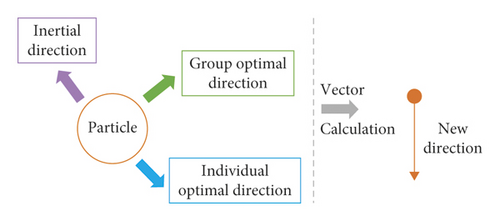
3.3. Evaluation Process
The PSO algorithm is based on a global search strategy to achieve fast optimization of velocity and displacement in the whole search area, and there are no unnecessary and complicated parameters to be adjusted, which is especially powerful for high-dimensional space in multi-metric prediction system. This method can be used to obtain the optimal parameters, reduce the blind trial calculation process of LSSVM, and improve the overall accuracy of the model. The process of CUCE evaluation based on the PSO-LSSVM method is shown in Figure 3.
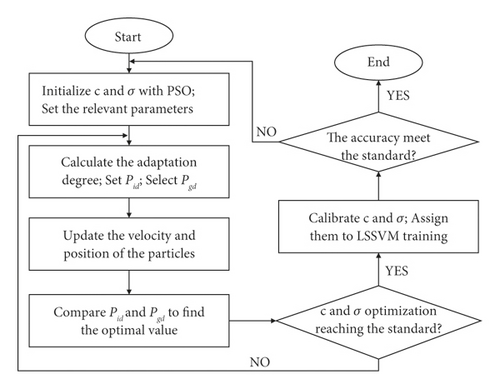
4. Experimental Results and Discussion
4.1. Experimental Results
In this paper, Hubei province, where there are many comprehensive universities, is selected as the research object. The initial data of the model are collected according to the proposed ECCU evaluation index system. The data for the study covered people involved in English programs at different schools, resulting in 124 valid data. The quality scoring range of ECCU is 0–5, where 0–1 means very low, 1–2 means low, 2–3 means medium, 3–4 means good, and 4–5 means excellent.
We set the parameter range of the PSO-LSSVM evaluation model as a way to avoid blind screening and save training time. The regularization parameter c takes values in the range [0.1, 200], and the kernel function parameter σ takes values in the range [0.1, 10]. The number of population particles is 20, the individual particle dimension is 2, the maximum number of iterations is 1000, the inertia weight coefficient w is taken in the range [0.3, 0.9], and the search parameters c1 = c2 = 1.8. The optimal values of the regularization parameter c and the kernel function parameter σ in LSSVM are 104.4302 and 5.2775, respectively, obtained by the PSO algorithm searching for the optimal value. The contrastive test method is often used in evaluation studies. In order to verify the applicability and superiority of PSO-LSSVM in ECCU, three comparison methods are selected in this paper: LSSVM, two commonly used machine learning methods: random forest (RF) and back propagation (BP) neural network (BPNN).
We divide the training and validation sets according to the ratio of 4 : 1. For showing the difference in accuracy of each method more intuitively, the overall data are divided into five sets in this paper. The accuracy comparison results on the training and test sets are shown in Figures 4 and 5.
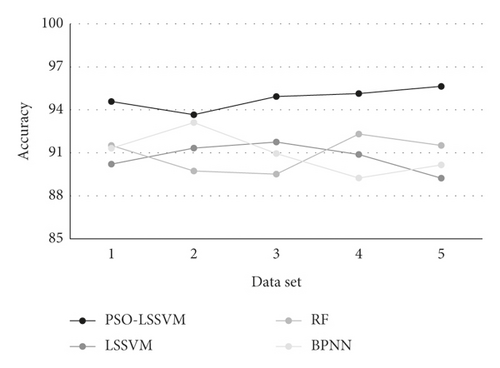
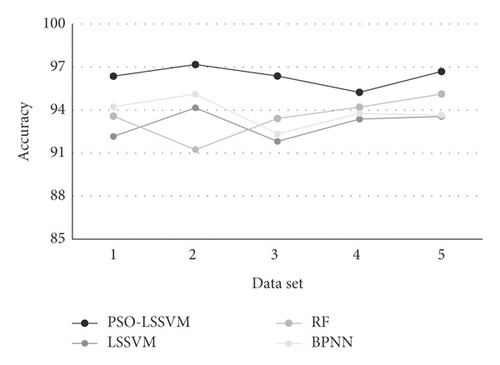
Figures 4 and 5 clearly show the performance of each method on the test and training sets. Obviously, the machine learning approaches and ECCU are well adapted, with overall accuracies above 90% on the test set. And there is no overfitting. The PSO algorithm is clearly optimized for the LSSVM method and is in a superior position on all data sets. The average accuracy of the PSO-LSSVM method on the validation set is 94.79%, which is 4.11%, 3.88%, and 3.84% higher than those of the LSSVM, RF, and BPNN.
After the accuracy of the model was proved, we invited English education experts to evaluate the ECCU level of four famous universities in the province. The results are shown in Table 2, which are consistent with the reality. English as a basic subject in comprehensive universities basically covers students of all majors. Overall, the ratings are mostly moderate or above. WU as a top university has similarities between its English teaching methods and the kernel of our index system. It mainly contains concepts such as collaboration, interaction, and wisdom, as well as preparation, practice, and output.
| Comprehensive university | WU | HUBU | YU | CTGU |
|---|---|---|---|---|
| Score | 4.11 | 3.02 | 2.83 | 3.25 |
| Grade | Excellent | Good | Medium | Good |
4.2. Discussion
With the accelerating process of educational reform, new requirements are put forward for English education in comprehensive universities. Students’ English ability should be able to serve their own profession while improving their independent innovation ability. The quality of English education has a direct impact on students’ English proficiency and, in turn, on their future diplomatic skills. In the context of economic globalization, it is especially important to improve the quality of ECCU. The right remedy is the best solution, and understanding the level you are at is the beginning of improvement, which is the value of evaluation studies. The ECCU evaluation index system in this paper has a high degree of reasonableness. The PSO-LSSVM evaluation method is highly accurate and practical, so it can be widely used.
On this basis, this paper provides in-depth reflections on the practice of ECCU enhancement. First, it is necessary to build a rich English language communication environment. Through this environment, students can actively participate in teaching and learning interactions, thus effectively stimulating their interest in learning and improving their English literacy. Students are encouraged to create English teams and to actively engage in English school culture activities. This promotes the organic integration of English teaching and learning inside and outside the classroom.
Second, there is a need for continuous innovation in English teaching mode. English teachers are facing students from different majors, so their teaching concepts and approaches need to be highly applicable. Traditional teaching does not focus enough on developing students’ cultural awareness and practical use. This requires a dual reform inside and outside the classroom. Modern teaching methods can effectively compensate for the shortcomings of traditional classrooms. Systems such as intelligent voice recognition and smart teaching are used to immerse students and allow for timely feedback, as shown in Figure 6. A large number of learning resources can be included in the smart classroom through data interconnection technology, which can meet the needs of all aspects of speaking, listening, and writing. In the smart classroom, teachers should also continue to improve their information technology skills. They are supposed to guide students to make use of rich online resources. Furthermore, focusing on mobile teaching can warm up the classroom atmosphere and increase student-teacher interaction. In addition to effectively deepening students’ understanding of British and American culture, they are willing to explore on their own, thus increasing their motivation and efficiency in learning English.
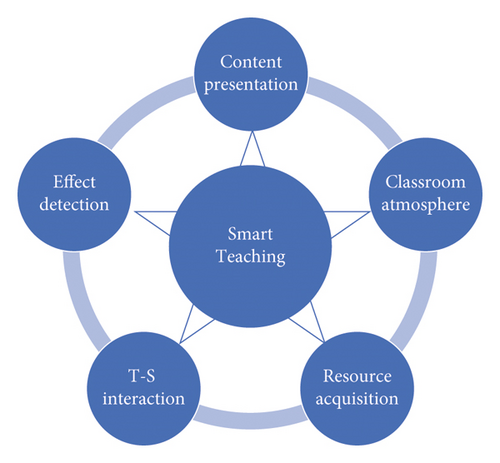
Finally, in order to achieve better teaching objectives, teachers can collect and scientifically analyze the data from students’ tests and assessments. With a good understanding of students’ problems and needs, teachers can make timely adjustments to classroom teaching to improve the quality of teaching. Therefore, a combination of formative and summative evaluation can be used.
5. Conclusion
Educational evaluation occupies an important position in the education system of comprehensive universities. For English, a basic course, the establishment of a scientific teaching quality evaluation system and evaluation methods is a crucial means to measure students’ standards and promote their language learning. In order to meet the needs of ECCU development, based on the interaction of practical information and expert experience, this paper adopts the machine learning method to evaluate multi-indicator data and obtains good results. A solid foundation is laid for improving students’ subjective motivation and overall language quality.
By meticulously analyzing the influencing factors of ECCU, a total of 16 three-level indicators in five aspects, Teaching Content, Teaching Method, Teaching Procedure, Teaching Literacy, and Teaching effect, are extracted to establish the ECCU quality evaluation system. We present an exhaustive description of the LSSVM method and optimize the kernel parameter σ and the regularization parameter c of the LSSVM by the PSO algorithm. Then, we input the optimized parameters into the LSSVM and construct the ECCU evaluation model. The accuracy evaluation results show that the PSO-LSSVM method has higher accuracy and applicability than other similar models. Based on the index system and the evaluation model, the optimization scheme such as smart teaching is proposed. This paper is the basic part of ECCU research, and there are still some imperfections because of the limitation of research conditions. In the future research, relying on big data technology, we can construct a combined qualitative and quantitative index system to make it more convincing.
Conflicts of Interest
The author declares that there are no conflicts of interest.
Acknowledgments
This work was supported by the Huanghe Science and Technology University.
Open Research
Data Availability
The labeled data set used to support the findings of this study is available from the corresponding author upon request.




